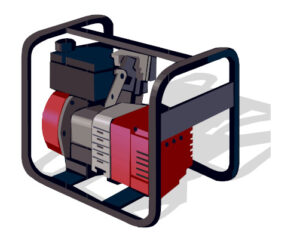Safety Reminders

The rule refers to the distance extending ten feet in every direction from any power line. It’s the distance you should observe when you’re working outdoors with equipment or machinery, such as a crane, forklift, backhoe, dump truck, TV antenna, drilling rig, or block loader.
It’s also important to remember that Missouri law requires you to notify the co-op anytime you work near a power line.
So play it safe, and remind your coworkers and neighbors to practice the “ten foot rule” too.
It’s the Law
It’s now the law in Missouri that anyone working within ten feet of a power line must notify the utility first so that proper safety precautions can be exercised.
With the Overhead Power Line Safety Act, any person who accidentally comes into contact with a power line, and didn’t contact the utility first, will be the negligent party.
Safe Electricity® is an award-winning, multi-media public awareness program of EEC. Since the program’s creation in 2001, Safe Electricity® has been providing information to consumers and helping compliment the safety education activities of utilities and educators. The program provides life-saving information through many channels—including its comprehensive website, radio and television public service announcements, videos, and more.
Click here to view the resources available:
Surprise ice and snow accumulations in the winter, and even in the spring, are a cold reminder of the difficulties involved in running a modern farm when the power goes out.
That is why a standby power generator can be good insurance to keep critical facilities running, according to Bob Schultheis, natural resources engineering specialist, University of Missouri Outreach and Extension.

If you plan to use a standby generator during power failures, Schultheis recommends first notifying your local electric utility company and then following the manufacturer’s maintenance instructions for the generator.
The National Electrical Safety Code requires that a double-throw transfer switch be installed to disconnect the consumer’s load from the power supplier’s utility grid. “The generator must be capable of providing adequate power at the correct voltage without putting occupants or utility workers at risk,” said Schultheis.
Portable generators with 4- to 5-kilowatt ratings are the minimum size needed for a typical three-bedroom home, and prices can range from $600 to $4,000. More expensive units run quieter, are more durable and have larger fuel tanks.
But whether it’s a direct-connected engine-driven unit or one driven by a tractor power-take-off (PTO), make sure a double-pole, double-throw transfer switch is properly installed by a licensed electrician.
This switch disconnects the main power source from the standby generator and prevents electricity made by the generator from mistakenly flowing out onto utility lines where it could electrocute members of the repair crew. The switch must have the capacity to carry the total load of the farm or building it feeds, even though the generator has less capacity.
Generators are rated in kilowatts. One kilowatt equals 1,000 watts. If the nameplate has two-kilowatt ratings, the larger number is the “short-time overload capacity” and the smaller is the “continuous-output rating.”
“Electric motors draw three to five times more power at starting than when running under full load, so proper generator sizing is critical to avoid motor burnouts. The ampere rating of equipment needing power can be converted to watts by multiplying its voltage by its amperage as given on the nameplate,” said Schultheis.
To size automatic-start units, add the wattage of all motors connected to the generator and multiply this number by 3.5. Then add the wattage of all other connected equipment.
To size manual-start units, you need to know the starting wattage of your largest motor, then add the maximum running- and starting-wattage demand on the generator at any point in the system to get the required generator size.
For example, a 5-horsepower, 5,000-watt running-load motor has a starting wattage of 17,500 watts, so an 18 KW generator is needed to start the motor. For PTO-driven units, the tractor should have a horsepower rating at least twice the kilowatt capacity of the generator. A 15 KW generator requires at least a 30-horsepower tractor to drive it at full load.
For more information on standby generators or other agricultural engineering questions, contact the University Outreach and Extension center in your county.
